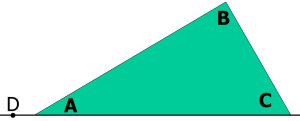\((-1)^{\frac{1}{2}}\Rightarrow\sqrt{-1}\) is a law of fractional exponents. In general terms, \(x^{\frac{a}{b}}=\sqrt[b]{x^a}=\left(\sqrt[b]{x}\right)^a\)
Why is this the case? Well, I can attempt to explain it to you.
The law of exponents explains how to handle multiplication of exponents with identical bases.
\(x^3*x^2=x^{3+2}=x^5\)
Let's try another example but with fractional exponents.
\(3^{\frac{1}{2}}*3^{\frac{1}{2}}=3^{\frac{1}{2}+\frac{1}{2}}=3^1=3\)
In this example here, \(3^{\frac{1}{2}}\) is a number that when multiplied by itself yields 3. That sounds like the definition of the square root, doesn't it? Therefore, \(3^{\frac{1}{2}}=\sqrt{3}\). One can also expound upon this.
| \(3^{\frac{1}{3}}*3^{\frac{1}{3}}*3^{\frac{1}{3}}=3^{{\frac{1}{3}}+{\frac{1}{3}}+{\frac{1}{3}}}=3^1=3\) |
| \(3^{\frac{1}{4}}*3^{\frac{1}{4}}*3^{\frac{1}{4}}*3^{\frac{1}{4}}=3^{\frac{1}{4}+\frac{1}{4}+\frac{1}{4}+\frac{1}{4}}=3^1=3\) |
| \(3^{\frac{1}{5}}*3^{\frac{1}{5}}*3^{\frac{1}{5}}*3^{\frac{1}{5}}*3^{\frac{1}{5}}=3^{\frac{1}{5}+\frac{1}{5}+\frac{1}{5}+\frac{1}{5}+\frac{1}{5}}=3^1=3\) |
| \(3^{\frac{1}{x}}*3^{\frac{1}{x}}*3^{\frac{1}{x}}*...*3^{\frac{1}{x}}*3^{\frac{1}{x}}=3^{\frac{1}{x}+\frac{1}{x}+\frac{1}{x}+...+\frac{1}{x}+\frac{1}{x}}=3^1=3\) |
The pattern continues. \(3^{\frac{1}{3}}\) is a number that when multiplied by itself 3 times yields 3. This is the definition of the cubic root. Then, as you can see, I made a generalization. \(3^{\frac{1}{x}}\), when multiplied x times, yields 3.
I believe I have gotten the answer to this riddle! Using the slope formula, one can find the value for a, if a solution exists.
\(m=\frac{y_2-y_1}{x_2-x_1}\)
Just plug in the appropriate values for the x- and y-corrdinates and solve.
| \(\frac{5a^2-3a^2}{3a+4-(2a+4)}=a+3\) | Now, solve for a. First, distribute the negation to all the terms inside the parentheses. |
| \(\frac{5a^2-3a^2}{3a+4-2a-4}=a+3\) | Simplify the numerator and denominator in the fraction because both happen to have like terms. |
| \(\frac{2a^2}{a}=a+3\) | Both the numerator and denominator can cancel out an "a." |
| \(2a=a+3\) | Subtract a from both sides. |
| \(a=3\) | Wow! There is actually a solution! |
In case you are wondering, this is correct. Click here to view the corresponding graph.
I can explain how to simplify for you! First, let's solely worry about the square root of a negative number first.
| \(4*\textcolor{blue}{\sqrt{-9}}-2\) | |
| \(\sqrt{-9}=\sqrt{9}\sqrt{-1}=\sqrt{9}i=3i\) | By definition, \(i=\sqrt{-1}\). Here, I broke up the radical into two separate parts. |
| \(4*\textcolor{blue}{3i}-2\) | Operations with imaginary numbers are the same as with a generic variable. |
| \(12i-2\) | Now, rearrange into \(a+bi\) format such that a is the real part and b is the coefficient of the imaginary part. |
| \(-2+12i\) | |
Another option is to utilize something called the Exterior Angle Theorem. This theorem states that the measure of the exterior angle of a triangle is equal to sum of the two nonadjacent interior (also known as remote) angles. The diagram below does all the speaking for me.

Now that this theorem is established, we can save one step. In the given diagram, \(m\angle CAB+m\angle ABC=m\angle BCD\)
| \(m\angle CAB+m\angle ABC=m\angle BCD\) | Exterior Angle Theorem |
| \(m\angle CAB+85=120\) | Substitution Property of Equality |
| \(m\angle CAB=35^{\circ}\) | Subtraction Property of Equality |
Why is this the case? Well, I'm happy to show you why!

In this triangle, one is given that this is \(\triangle ABC\) with an exterior angle \(\angle BAD\). Our goal here is to prove that \(m\angle B+m\angle C=m\angle BAD\). I will utilize a two-column proof.
Let's assume that \(m\angle BAC=x^{\circ}\).
| \(m\angle BAC+m\angle B+m\angle C=180^{\circ}\) | Triangle Sum Theorem |
| \(x+m\angle B+m \angle C=180^{\circ}\) | Substitution Property of Equality |
| \(m\angle B+m\angle C=(180-x)^{\circ}\) | Subtraction Property of Equality |
| \(\angle BAC\) and \(\angle BAD\) form a linear pair | Definition of a linear pair |
| \(\angle BAC\) and \(\angle BAD\) are supplementary | \(\)Linear Pair Theorem |
| \(m\angle BAC+m\angle BAD=180^{\circ}\) | Definition of supplementary angles |
| \(x^{\circ}+m\angle BAD=180^{\circ}\) | Substitution Property of Equality |
| \(m\angle BAD=(180-x)^{\circ}\) | Subtraction Property of Equality |
| \(m\angle B+m\angle C=m\angle BAD\) | Transitive Property of Equality |
A midsegment is a segment joining the midpoint of two sides of a triangle. Each triangle has 3 midsegments. The Triangle Midsegment Theorem states that a midsegment of a triangle is parallel to the nonintersecting side, and its length is half the length of the nonintersecting side.

In this diagram here, \(\overline{BD}\), the midsegment, bisects both of its intersected sides. Also, \(\overline{BD}\parallel\overline{AE}\) and \(\frac{1}{2}\text{AE}=\text{BD}\).
Knowing this information, we can then determine where the coordinates of the endpoints of the midsegment will be.
Let's find the midpoint of both of the segments.
| \(\text{MDPT}_{\overline{PR}}\left(\frac{x_2+x_1}{2},\frac{y_2+y_1}{2}\right)\) | Find the midpoint of the segment PR using this formula. |
| \(\text{MDPT}_{\overline{PR}}\left(\frac{-3-4}{2},\frac{3-2}{2}\right)\) | Simplify from here to find the midpoint. |
| \(\text{MDPT}_{\overline{PR}}\left(\frac{-7}{2},\frac{1}{2}\right)\) | Since the answers must be in decimal format, I will convert them. |
| \(\text{MDPT}_{\overline{PR}}\left(-3.5,0.5\right)\) |
Now, find the other midpoint.
| \(\text{MDPT}_{\overline{QR}}\left(\frac{2-4}{2},\frac{1-2}{2}\right)\) | Simplify from here. |
| \(\text{MDPT}_{\overline{PR}}\left(\frac{-2}{2},\frac{-1}{2}\right)\) | |
| \(\text{MDPT}_{\overline{PR}}\left(-1,\frac{-1}{2}\right)\) | |
| \(\text{MDPT}_{\overline{PR}}\left(-1,-0.5\right)\) |